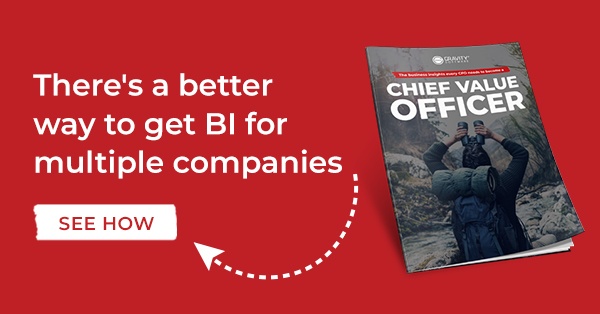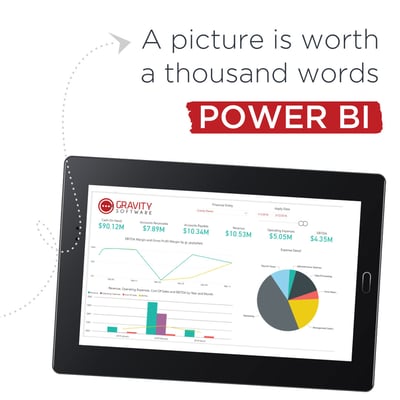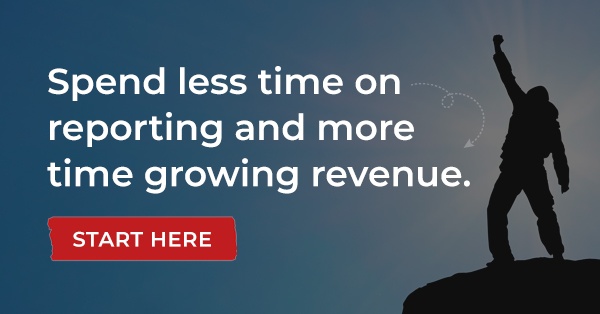How to use business intelligence solutions to drive enterprise growth

Company leaders look to their chief financial officers for strategic direction, not just the latest financial reports.
“CFOs today are expected, from an internal management perspective, to provide real-time insights from data of all types, also increasing beyond the scope of purely financial insights,” Ernst & Young says.
Fortunately, with the right accounting software and business intelligence solutions, providing this insight is easy.
Business intelligence: future trends
It's important to keep your finger on the pulse of your company's data because if you don't pay attention to it, someone else might.
And you may not like what they do with it.
"Companies which do not intensively use data analytics can be overrun by external analytics results," EY cautions. "This could lead to unwanted public attention … and change the way customers perceive them.”
Transparency surrounding your company's data is a way to broker a relationship of trust with external stakeholders. But it’s also invaluable to your internal stakeholders.
Software review company SelectHub makes several key predictions about the future of business intelligence.
First, business intelligence solutions will become more collaborative, enabling team leaders across departments to make decisions faster. These solutions will also become more integrated with a company’s existing technologies — such as accounting software and CRM systems.
This creates a single source of truth for company data, rather than having silos of information scattered across the enterprise.
Additionally, business intelligence solutions will become more intuitive with advancements from machine learning and artificial intelligence. They could, for instance, provide more specific answers to inquiries depending on different variables.
As these trends evolve, company leaders will need more sophisticated business intelligence solutions to stay competitive. However, greater sophistication doesn’t necessarily mean adding complications. These solutions still need to be easy for everyone to use, from accountants and purchasing managers to CFOs and CEOs.
4 big business intelligence opportunities
While data visualization enhances monthly reports, the true benefit is that “people are better able to make decisions if the data is put into a format that is easy to engage with,” said David Kirshner, Health Market Lead for Ernst & Young LLP.
That means compiling it into real-time dashboards, charts, graphs, and side-by-side comparisons.
In some ways, business intelligence flips the question-and-answer paradigm: It provides the answers and then you ask the questions.
The best business intelligence solutions provide numbers and statistics in a clear and understandable way. Your team uses its knowledge to interpret, analyze, and act upon those insights to shape your strategy and accelerate your growth.
There are several key types of business intelligence that are especially relevant for growing enterprises.
Customer data
Every successful organization understands their customers’ buying habits and uses that information to uncover new sales opportunities.
Business intelligence can help you analyze the transaction history and behavioral patterns of your customers to determine their customer lifetime value. CLV is significant, as 80% of future profits come from 20% of your existing customers.
On the other side of the consumer loyalty coin is customer churn, or turnover.
Business intelligence can help you gain insight into why customers are loyal and what makes other customers disappear after one or two transactions. Your team can use that insight to find your high-value customers and reward them with new incentives.
Marketing
While customer loyalty is integral to the continued success of your business, your enterprise won't grow unless you attract new customers or upsell to existing ones.
That's where marketing comes in.
Using business intelligence to delve into marketing data can help your leadership understand how many leads each marketing campaign generated and how many of those leads ultimately resulted in purchases.
You can then zoom out on the data to find out your overall customer acquisition cost. From there, you can decide whether to rethink certain marketing tactics or double down on others.
Inventory
Say your company is an outdoor supply retailer. Using business intelligence solutions, you find you're allocating a portion of your inventory budget to a camping accessories vendor that is disproportionate to the amount of revenue those items generate.
Should you renegotiate with this vendor to purchase less from them in the future? Should you look at increasing your markup on camping supplies? Or should you consider a different supplier?
You may know your company's overall inventory costs, but do you know whether you're overstocked or understocked on particular items based on purchasing trends from the year so far? Whether inventory costs are trending upward or downward?
Business intelligence can help you understand all of this and more.
Capital allocation
Business intelligence from your accounting software can help you drill down to see each aspect of your company's operations, much like being able to view individual tiles in a mosaic.
Those aspects come together to form a picture of how your company is faring in the present and where it’s headed in the future.
Business intelligence can help you see that picture more clearly, too.
With a single pie chart, BI can help you answer one of the broadest, yet most important, questions you can ask about your business: What is your company spending its money on?
The answer may surprise you. You probably already know labor costs were your company's biggest expense and real estate was No. 2, but you may not have realized how little you spent on marketing compared to your overall revenue — or how much you spent on warehouse storage costs. With business intelligence, you can get an accurate, evidence-based view of your company's capital allocation rather than relying on guesswork.
Get built-in business intelligence solutions with Gravity
As valuable as these insights are, they’re not always easy to acquire without purchasing a separate solution. The cost of business intelligence software can range from a few hundred dollars per month to several thousand, depending on how many users you need, according to Software Connect. However, Software Connect also notes that about 70% of BI software users only need to use it on a limited basis, for a few specific things.
They might only need to see purchasing trends on a dashboard or a high-level overview of your company’s costs broken down into a pie chart.
Unfortunately, these solutions aren’t always designed to integrate well with your accounting software, CRM, or other business-critical systems. That makes it difficult for your accounting team to access the information they need to forecast future growth, compile reports for investors and other stakeholders, and make adjustments to improve your financial outlook.
For companies with multiple entities, gaining real-time business intelligence can be especially challenging because the data comes from so many different sources.
The good news is that Gravity Software makes it infinitely easier.
Because Gravity Software is built on the Microsoft Power Platform, it already has Microsoft Power BI built in, so your team doesn’t need to invest in separate solutions for accounting and business intelligence.
Power BI is one of the best business intelligence solutions, recognized by both Gartner and the Forrester Wave™ as a leader in the marketplace.
With the combined power of Gravity and Microsoft Power BI, your accounting team and anyone at your organization can create visually appealing, easy-to-understand dashboards that highlight the data most relevant to them.
Your finance department can use real-time dashboards for customer data, inventory, marketing data, total capital allocation, and more.
You can also see:
- Total revenue, expenses and income across multiple entities
- A breakdown of all your expenses
- Your top customers and their purchases
- Inventory allocation
- Where your product is most popular across the country or the world
You can even use Power BI to track the performance of private equity investments.
It’s easy to personalize these dashboards or build reports designed to show exactly what you need, without involving a developer.
And you can easily integrate data from other business apps into your BI platform to give you a full picture of your company’s performance.
Any of Microsoft Power BI's dashboards can be embedded within a team member's Gravity dashboard, giving them instant visibility into the metrics that matter most to them.
Gravity Software is continually developing new ways to leverage the Microsoft Power Platform to provide the most comprehensive data analytics abilities.
We’re working on a dashboard that allows users to predict next month’s cash flow based on sales projections and bills.
We know how vital business intelligence is to your organization. That’s why we made it a core feature of our software, so your accounting team can deliver the insights every key stakeholder needs to improve the bottom line.
Want to add even more value to your enterprise? Check out our resource, The financial professional’s guide to more synchronized accounting.
Gravity Software
Better. Smarter. Accounting.




